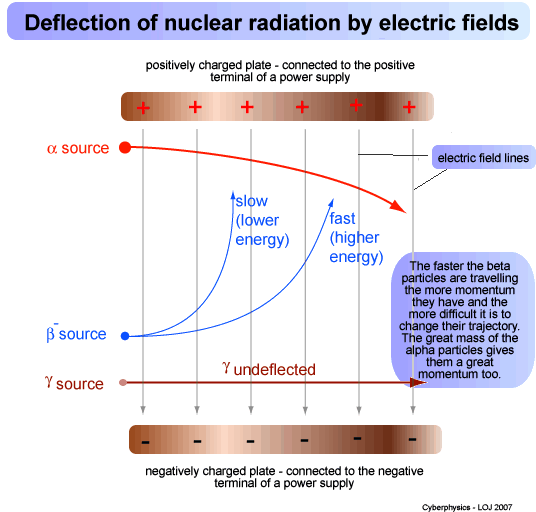Deflection of nuclear radiation by electric and magnetic fields
Charged particles are affected by electric fields. An electric field is the area around a charged object. it forms a 'landscape' for charged objects rather like hills and vales in the 'charge dimension'. This makes charges accelerate as they move in a potential gradient, just like a ball would accelerate if it rolled down a hill. If two parallel plates (one negative and one positive) form an electric field that particles from radioactive decay are made to travel through the particles that are charged will accelerate towards the plate with opposite charge. An alpha particle will therefore accelerate towards the negative plate and the beta (minus) particle towards the positive plate. The gamma ray has no charge so it is not affected by this 'electric landscape' and will just continue on its straight path. A beta- particle (β- - a high energy, fast moving electron) has much less mass than an alpha particle (a helium nucleus) - it has mass of 1/7300 of an alpha particle. A typical velocity for an alpha particle is about 16 km/s , whereas the typical speed of a beta particle is about 270 km/s - about 17 times the speed. But despite the greater speed, the larger mass makes the alpha particle have a lot more momentum than the beta particle. Therefore an alpha particle is deflected less that an beta particle in a given electric field because of its higher momentum. Higher level: A positron (Beta+ or β+) would be deflected in a similar manner to the beta- particle but in the opposite direction because it has a positive charge.
When charged particles move a magnetic field is created around them. That magnetic field can be affected by other magnetic fields. Therefore charged particles experience a force when they travel in a magnetic field. They only experience a force when that field is at right angles to the path they are travelling. The force acts mutually at right angles to the direction the particle is travelling and the direction of the field so the particle takes a circular path. F = qv x B
(The force is applied at right angles to their path - therefore they are forced into moving in a circlular path). Again, due to higher momentum the apha particle is less affacted by the force of the field than the beta- particle is. Higher level: A positron (Beta+ or β+) would be deflected in a similar manner to the beta- particle but in the opposite direction because it has a positive charge. The direction it will go in can be found using Flemings left hand rule. At GCSE you do not need to know which way it will move but at A level you do. See here |
Follow me...
|







